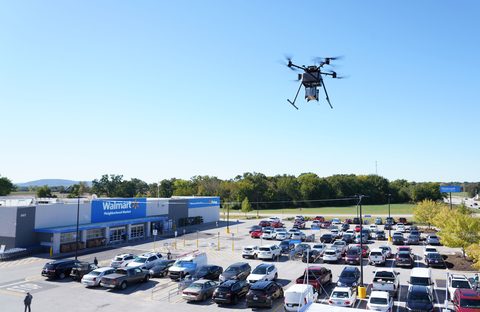

By Jim Magill
DroneUp, which said it would shut down its drone delivery operations conducted in partnership with Walmart in three states, instead plans to focus on flights in the Dallas/Fort Worth area, where the economics for growth are more favorable, a company official told DroneLife.
“For DroneUp, what drives our operations in Dallas are factors such as strong state government support, a high concentration of customers, favorable weather and terrain, collaboration opportunities with other industry players, and its central location, which provides easy access from nearly anywhere in the USA,” DroneUp chief technology officer John Vernon said in a statement.
Earlier this month, DroneUp CEO Tom Walker had told Axios that the drone delivery provider would shutter 18 Walmart delivery hubs located in Phoenix, Salt Lake City and Tampa. The realignment would result in the layoff of about 70 employees or about 17% of DroneUp’s total staff, Walker had said.
Vernon said the company’s strategy of focusing on the D/FW area would allow it to develop higher capacity hubs that could handle a higher volume of deliveries.
“Since these hubs launched in 2022, we’ve been focused on learning about consumer and community acceptance, efficient operations and building a strong safety record,” he said. “By focusing on key markets, we can better hone our technology and grow more efficiently.”
DroneUp recently announced that it has achieved a new industry milestone with the ability to make 500 deliveries per day.
Vernon said the operator’s ultimate goal is to make drone deliveries more economically viable by placing them at parity with other instant delivery methods such as DoorDash or Uber Eats.
“DroneUp already offers the qualitative benefits of faster delivery time (not including selection and packing) that supports hotter (or colder) food, without concerns of delivery tampering,” he said.
Walker had said that it currently costs DroneUp about $30 to deliver a package by drone. The company’s goal is to slash the cost to below $7. This would place delivery by UAS on a price parity with ground-based delivery methods, while accomplishing the delivery at a much faster pace.
Currently DroneUp operates from 11 Walmart locations in in the DFW region, Dallas, Plano, Murphy, Richardson, Mesquite, Rowlett, Colony and three locations in Garland.
The decision to concentrate operations in the D/FW region reflects a shift in Walmart’s roll-out strategy for drone delivery operations.
Last January, Walmart announced plans to expand its drone delivery services in the D/FW area, in cooperation with DroneUp, as well as Wing and Zipline, to cover 75% of the households in the region.
In May, the retail giant said it would expand its DroneUp delivery network to 34 sites across six states by the end the year, providing the potential to reach 4 million U.S. households and to deliver more than 1 million packages by drone in a year.
However, in a recent statement a Walmart spokesperson said the retailer’s current strategy is to focus on “saturating” the DFW drone delivery market with the goal of understanding what drone delivery operations could look like at scale.
The spokesperson said Walmart and Wing recently opened two new drone delivery sites in the D/FW region as part of its expansion plan announced in January. Zipline, which is also part of the expansion plans will begin operations in the DFW area in the coming months.
These Wing hubs and forthcoming Zipline locations will add to the 11 hubs currently operated by DroneUp in the DFW area. In addition, DroneUp will continue to operate from three Walmart stores in Arkansas and on in Virginia, the spokesperson said.
Vernon pointed to the development of the D/FW UAS Traffic Management (UTM) initiative as a key driver in the evolution of the D/FW area into the hub of drone delivery in the U.S.
Last month, the FAA announced that as a result of the successful implementation of the UTM system, it was approving drone flights without a visual observer by both Zipline and Wing, marking the first-ever approval of BVLOS operations by more than one operator flying in the same airspace.
DroneUp, Vernon said, was one of the initial architects responsible for the development of the UTM system in the region.
“We’ve been deeply involved in transitioning UTM from controlled test environments to practical, real-world applications,” he said. “From the outset, DroneUp was one of the few industry leaders actively defining the participation requirements and guiding the process.”
Miriam McNabb is the Editor-in-Chief of DRONELIFE and CEO of JobForDrones, a professional drone services marketplace, and a fascinated observer of the emerging drone industry and the regulatory environment for drones. Miriam has penned over 3,000 articles focused on the commercial drone space and is an international speaker and recognized figure in the industry. Miriam has a degree from the University of Chicago and over 20 years of experience in high tech sales and marketing for new technologies.
For drone industry consulting or writing, Email Miriam.
TWITTER:@spaldingbarker
Subscribe to DroneLife here.
